Contents
- Death Is Not The End
- Bringing Death And Horror to life
- Supernatural & Horror Sound Effects
- Dead Letter Drops
- Happy Horrors
- All horrors eve?
- Unnatural Sound Effects
- Radiophonic in origin
- Die(l) A Disk
- New work, London, Paris, Murder
- Off The Shelf
- Copyright
- Sleeve Artwork
- In Living Mono
- FX13
- Release The Release With Hounds!
- Fangs Very Much
- Conclusion
Death Is Not The End
Two years ago I wrote a long post about BBC Records’ sound effects albums, and no.13 in particular. I wanted to put Death & Horror Sound Effects in context as well as telling as much of its story as I could. Now, here’s another long post about Death and Horror. A predictable sequel where the original bad guy comes back from the grave? Or a highly entertaining return for an anti-hero fan favourite? Actually, it’s that other franchise staple: the origin story.
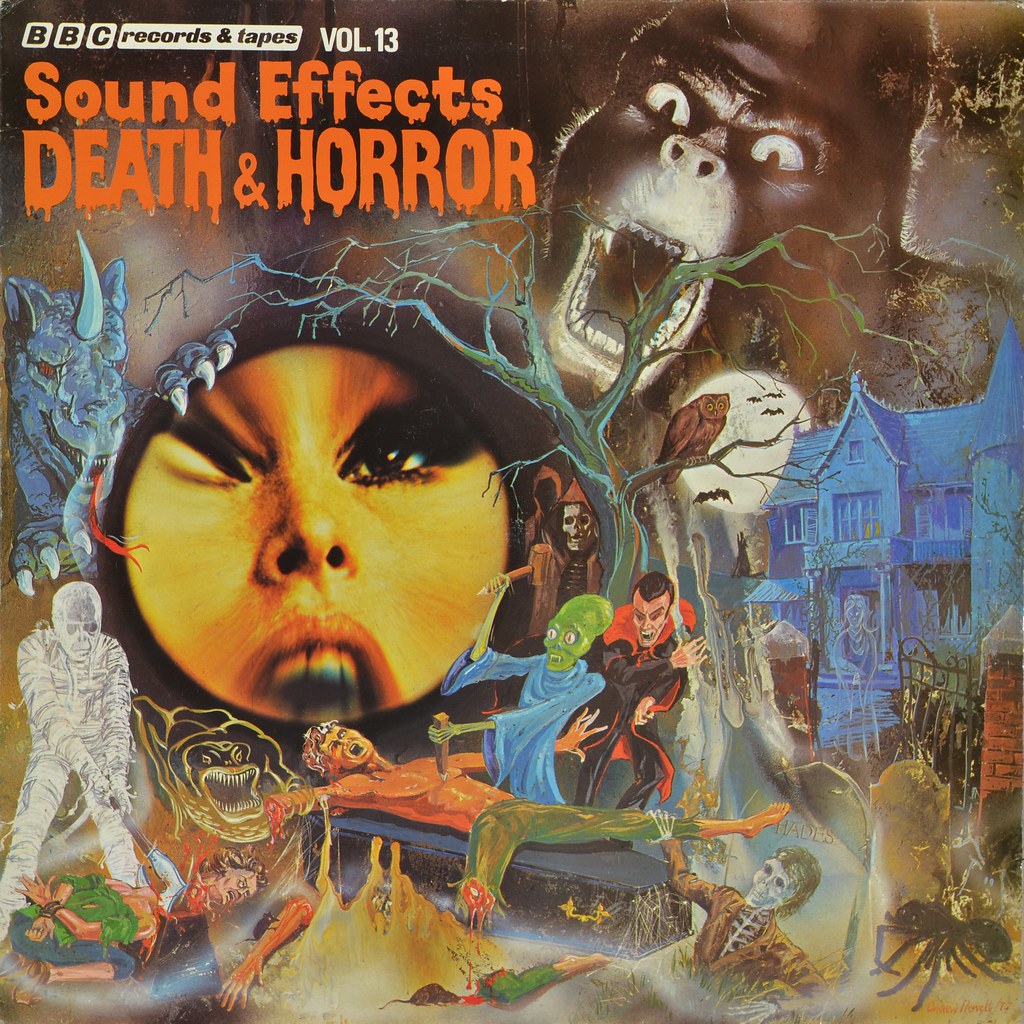
Bringing Death And Horror to life
Whereas before I was referring to mostly pubic domain information, now I can prise open the tomb and exhume the story of a landmark BBC LP. Given access to the BBC Written Archive I have seen the extensive original file on this record, including hand-written notes, memos, letters and documents that reveal just how it came to life. Or should that be…
Supernatural & Horror Sound Effects
The paper-trail begins on 10th August 1976 when Death and Horror’s (D&H) producer at BBC Records, Mike Harding (not that one) wrote two letters from his office at 80 The Langham. Both are headed PROPOSED LP OF SOUND EFFECTS, and both begin
“We are putting together an LP of supernatural
R125 / 263 / 1
and horror sound effects.”
Dead Letter Drops
Drama…
One letter is sent to Roy Maynard, Programme Operations, Radio, at Broadcasting House; just across the road from The Langham. Roy Maynard was responsible for ‘Off Beat Sound Effects'(REC 198, 1975) but Mike was not asking him to help directly. Mike might have been aware that Maynard had not found his work on that record sufficiently well appreciated by the in-house label. In a memo dated 25th September 1975 he had replied to Jack Aistrop, Head A&R at BBC Records, about the latter’s request for another sound effects record. Maynard points out that he was not remunerated for that despite the work he and his staff did on their own time. Signing off with a jokey threat about the pistol he kept in his desk drawer you get the sense that any future approach would need careful handling.
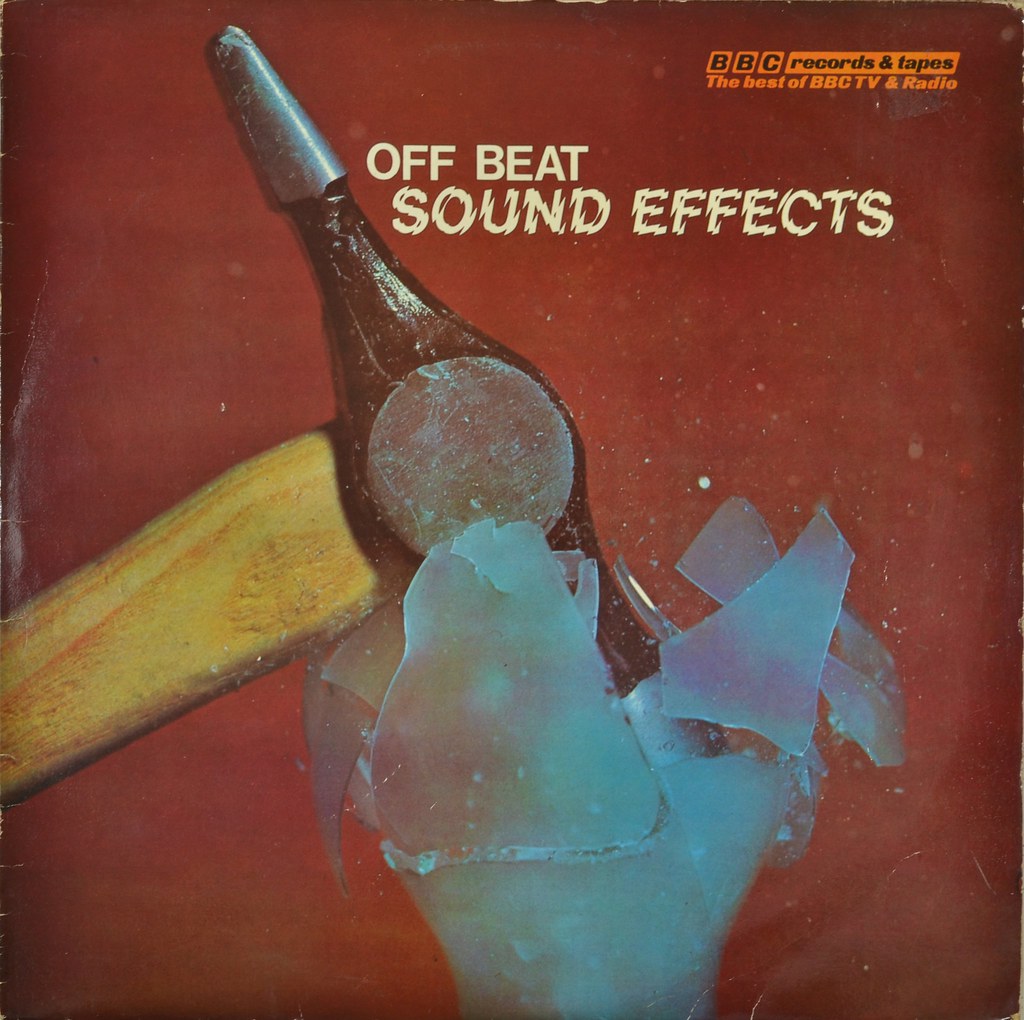
The polite request this time is for the help of one of Maynard’s “SM’s”. BBC Studio Mangers will be familiar to students of the Radiophonic Workshop because so many of their staff came from these ranks. Distinct from engineers and technicians, who installed and maintained studio facilities the operation of a studio to achieve a broadcast or recording fell to the SMs. They managed the studio, not the talent. It fell to producers to bring in the actors and presenters.
Mike wasn’t making a blind request though.
“I have spoken to Ian Richardson who is keen to help”
R125 / 263 / 1
Whilst he does not insist on Richardson you get the impression that the two had cooked up this idea already. The alternative, he gives Roy would be have to be “someone who is ‘into’ this side of things”.
The specifics of this request are that the SM would both research existing effects and create new ones. The existing effects would come from the extensive BBC Sound Effects archive, which SMs would know better than most. The creation of new effects would also be the stock in trade of the SMs who provided ‘spot effects’. Spot here refers to ‘on the spot’ and means an effect created at the same time as the actors’ performance. Playing the effect live, as it were.
Whilst Richardson was said to be “keen” Jack Aistrop had probably arranged for a budget so that whoever was assigned would not have to give up their own time, and Maynard would have no complaint (or need to reach into his drawer!). Mike states that it is expected to take two or three days and any charges would be covered by BBC Records.
…Workshop
The second letter Mike sent that same day was to Desmond Briscoe, the Organiser of the BBC Radiophonic Workshop. For this missive Mike mentions that the album will be a follow-up to ‘Out Of This World Sound Effects no.12 (REC 225) which he adds “has sold very strongly indeed”. OOTW was produced by Workshop staff member Glynis Jones and released in March of 1976.

The request this time is simply for “someone to produce some of these effects”, but as with Ian Richardson Mike had a ‘someone’ in mind. Who else, but Dick Mills? There’s no hint that he has already discussed this with Dick and he simply asks if he is free. Speaking to Dutch radio in 1981 though, Dick explained that they at the Workshop had got wind of this project.
“when we found out that they were doing Death & Horror sound effects records we said ‘would you be interested in any of our sounds…?”
Rauhfaser – Brom en Ruis – afl 162/1v2 – ‘Radiophonic Workshop BBC’ – 7 jan 1981
So, despite the formality of writing to Desmond, maybe there’d already been some informal chat between Workshop and label.
Glynis left the Workshop’s Maida Vale studios and went to work for BBC Records sometime in 1976. Paddy Kingsland’s suite of music from The Changes (RESL 33) came out the same year too, although it seems more likely that Mike’s new colleague would have briefed him on what and who to ask for. And as we’ll see, she was in the loop.
Happy Horrors
A week after his requests went out a reply from Roy Maynard was received on 17th August – glorying under his full title of Production Services Manager, Group 4, Programme Operations, Radio. Evidently they had spoken in the intervening days and he confirms (“as discussed”) that Ian Richardson will be available for the research and recording on 21st – 23rd September.
Roy signs off with advice to book the studio for the recording soon and a cheery “Happy Horrors”! All seems well between Roy and BBC Enterprises, so has a special deal has been done?
All horrors eve?
Thinking of the studio schedule: Wouldn’t D&H have been perfect for a Halloween release date? If Mike had held any hope of releasing D&H by Halloween then this recording date meant that was now out of the question.
Was that ever on the cards though? According to the BBC Records Operations Calendar (handily included in the OOTW file) the October release date fell on the 1st. The next possible release date would then be bonfire night. In fact though, for October to be possible the calendar says you’d need to have your booking forms to Miss Moor by 14th June!
Unnatural Sound Effects
“Some of these will be purely spot/disk or radiophonic in origin – some can be done by both methods.”
R125 / 263 / 1
Just under a week after securing the services of Ian Richardson, Mike writes to his colleague under the heading Horror Sound Effects (suggesting that the supernatural element had been exorcised). Glynis Jones is copied in too, showing that she was in the mix. We learn that the Paris Studio (not in Paris) had been booked for 22nd September from 10-6, and this will cover “spot/disk FX dubbing”. This means they will record the ‘spot’ effects and copy the effects which will be taken from the BBC effects library discs too.
Murders Mostly Horrid
The letter mainly provided a complete list of effects proposed for the album. This is very close to the eventual record, although a couple are notable for their later absence. Particularly eye-catching is “man hit by car”. This is certainly more in the Death category and it’s not surprising it was omitted. Erm. This time. Other suspicious deaths are ‘Man falling out of window’ a “burning at stake sequence’, ‘person drowning’ and the no less pleasant, but probably more controversial, ‘crucifixion’. That one was renamed and most of the other murders were committed to vinyl… in later D&H editions.
It’s easy to see all this as extremely distasteful, when taken for entertainment, but a lot of that stuff is an everyday occurrence in drama. It’s not recorded in this file but it’s quite probable that this list was compiled from requests that BBC Records had received. Indeed this fact was used in defence of the album later.
Radiophonic in origin
Moving forward a couple of weeks and Mike has been on the ‘phone (that’s how he wrote it!) to Dick Mills. The day after this call, 10th September, he writes to Dick, copy Ian and Glynis. As well as enclosing the same list of effects he sent to Ian, the letter sets out those which will be “radiophonic in origin”.
These ‘Radiophonic in origin’ effects are the Special Sounds which the Workshop was set up to create. Special Sounds are things which are impossible to capture either in the outside world or in front of a studio microphone. Or at least, not easily.
Hence Dick is asked for ghostly winds, supernatural creatures, laboratory and electric noises (think Dr Frankenstein), unnatural screams (“through a synthesizer”), the swinging pendulum (“as in Pit & Pendulum, Edgar Allen Poe), King Kong, swamps, squelching and some musical effects. One such is ghostly piano, but not actual music – “the usual fingers over the strings – no tunes please”. The other is ghostly organ “to suit a phantom of the opera”. The arrow arriving effect is specified “as in TV ad. for Strongbow cider!”.
Finally there’s a comment on mono and stereo recordings. Mike says he can “stereoize” anything in mono although he wants anything Dick is newly creating to come in stereo.
Die(l) A Disk
Next in the chronology is a set of five pages headed ‘Mike’. Given that we know Ian was booked to hunt through the effects library and you don’t usually write your own name at the top of whatever you’re writing, I think these are the notes he made. It’s also headed ‘FX’ and each section has an underlined sub-heading, such as “Various Winds” and “Inn Sign”. These follow the list Mike sent, with some additions.
Each of these ideas is expanded on in the sections with a list of possible effects from the sound effects library, including descriptions and the Sound Effects Centre catalogue numbers. Some of Ian’s notes refer to ‘spot’ effects as he identifies those sounds which are not on the effects library shelves and will be recorded by themselves. Others he notes as Radiophonic, as they are on the list Dick Mills will produce – And then they are crossed out,
To these jottings, Mike has added his own notes at several different times, using different pens. Many of these refer to effects from the BBC Records’ own Sound Effects series. For example, ‘Man Hit By Car’ is suggested as 84D and E, to which Mike notes “good skid”. Then he suggests “skids (on disc) + Thump (spot)”. Then “Car Crash on RED 76 no.2”. Finally “[illegible] up-to crash + then body thump”.
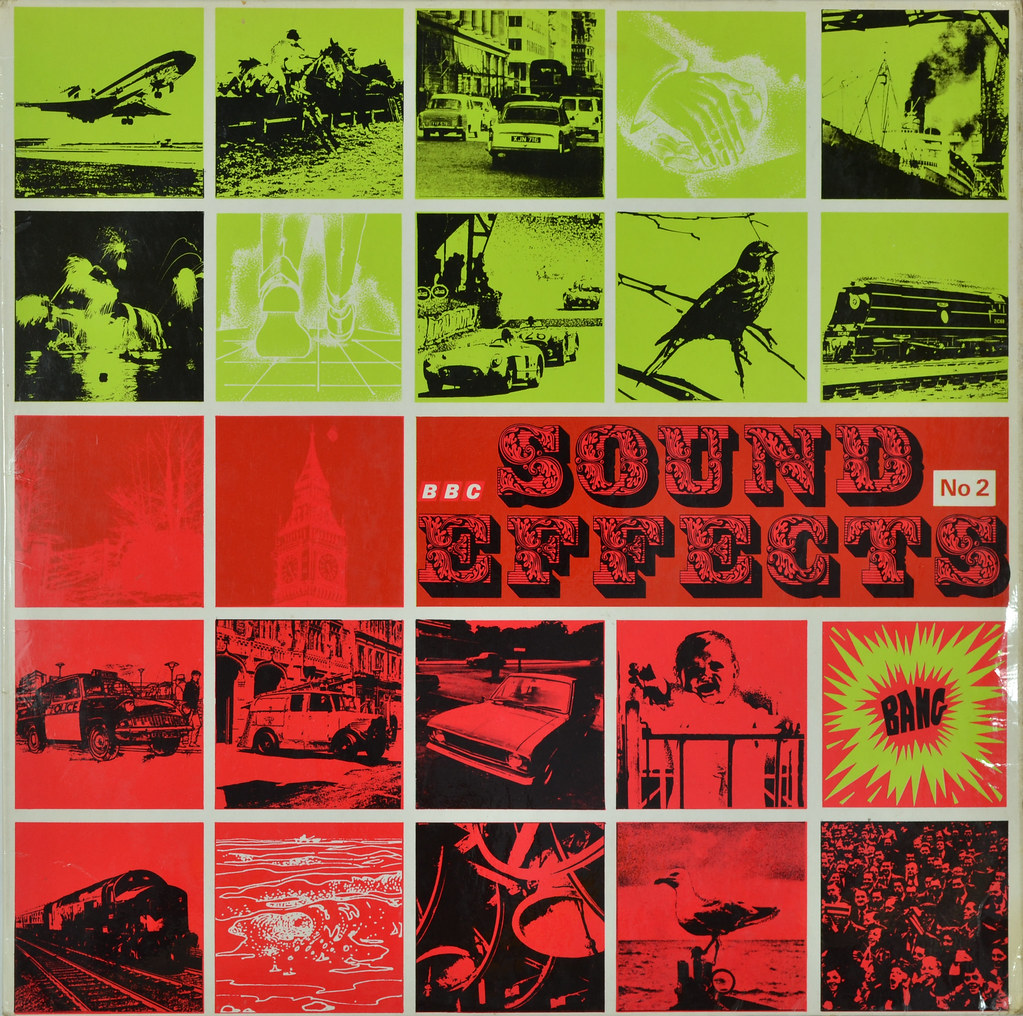
New work, London, Paris, Murder
Now we come to the recording session, which remember was booked for 22nd September. The booking form shows the date was set on 19th August, just after Roy Maynard’s advisory note on getting it done soon. It also shows that the form wasn’t despatched until 24th, which explains the gap before informing Ian of the date.
The Paris Studio was also better known as the Paris Theatre. This former cinema located on Lower Regent Street in London was used by the BBC for recordings with live audiences. Comedy, drama and many pop music performances were done there and Mike was doubtless familiar with it from his stint as presenter on Sounds Of The Seventies and their live shows; Ian wound likewise be at home there.
So, rather than a clean, sound treated studio they ended up in a live space. No mention is made of this choice in the paperwork present in the BBC archive, but I suspect that the mess with cabbages they were going to make might have been a factor. In the theatre I assume Mike was present with Ian. According the sleeve notes Lisa Braun was also involved although I can find no trace of her in the documents, except for a bit of different hand-writing which maybe is hers. It’s also clear that they’d need another pair of skilled hands to get the recordings done and perhaps the recording channel (room) would need an operator off-stage.
The file contains a page of hand-written notes headed “Paris 22/9/76”. This is all there is to document the day’s activities. A numbered list of twenty one effects and another of five more. It appears that each list refers to a tape. Speaking of tape, the booking form had specified that the producer would bring their own. These were the heydays of tape recording and there will be more tapes to come as the record is assembled.
The effects begin with guillotine slides (1), followed by the head dropping into straw (2), the blade through neck being crossed out and appearing out of sequence next (3). More neck violence (4) sawing head off (5) chopping with axe (6) and so on. Most of this matches the first band on the record, titled Execution and Torture.
What’s not always clear from these notes is what are spot effects and which are auditions of effects from “disk”. There are a couple of annotations which are obviously Sound Effects Centre (EC) catalogue numbers.
“84C good (b3)”
That refers to band 3 of the back side of 84C which contains wooden crashes. The note for that was probably added later as it’s in a different pen and is Mike comparing what they got in the studio with existing effects. Also, the list changes from Mike’s writing to another hand for effects 14-16 and then goes back to his. Those might be Lisa’s.
The second tape includes a load of throat work with screams and strangulations. Was Lisa there to provide the female takes? No, it seems they were taken from SFX records too.
As Ian’s sleeve notes make clear most effects on the record are from the effects library but they did use a real red hot poker on cabbages. This fire hazard must have required a certain amount of forethought, I’m sure they didn’t want to risk burning down the Paris Theatre or simply being thrown out for showing insufficient care. Let’s assume a brazier of hot coals wasn’t used, however it was actually done in practice.
Alongside the list of recordings committed to tape are notes in Mikes’s hand and a different pen. Obviously these are his thoughts on playback. Various comments such as “good”, “no use” and “last one” referring to specific takes. I imagine the tape consists of spoken cues – e.g. ‘Four: neck broken’ – followed by several takes. He also redefined some notes. “8 Hot poker through eye”, ditto 9, are confirmed as “into cabbage” and “into water” respectively. Here he starts to refine his ideas and adds “call it Branding” to the water one. There are several other notes about adding echo, which will come up again and again as he summons stereo from base mono sounds.
Off The Shelf
The next dated documents come a month after the Paris Studio session, on 20th October. Two letters, both requesting effects from the BBC Sound Archive.
He writes to an A.E. Trebble at ‘Archives’ asking for dubbing to tape copies of various creatures. Four in total from three discs, specified by their LP prefixed catalogue numbers. These numbers are an indication that these were not 78 discs but 33 RPM micro groove long players. Also this indicates that they are not simply the older generation of sound effects records, but archived sounds, a different purpose, but still useable as effects. None of these were on Ian’s original effects library notes, so maybe Mike went there in search of more stuff.
The BBC Sound Archives are distinct from the Sound Effects Library, whom he also wrote to at their Western House basement on the same day. This was a much longer list based on those notes from September and some new ideas.
The digging grave effect is requested from 83G – Digging in stony ground – not 186C (which was struck out) or 83K B1, which had been commented as “best”. However, digging in both wet and stoney ground is on the final album. In fact, all this digging came from the army and was recorded in 1970.
Of interest only to me is that Mike added the matrix number of every Sound Effects library record after the catalogue number. These are long numbers, tedious to type in by hand, so he evidently had good reason to do so.
Tapes from the cryptic
In both letters Mike asks for the dubbing at a specific tape speed – 15 ips for best quality – and Dolby coding in Channel H59. This mysterious entity seems to be a particular facility at The Langham where high quality Dolby noise reduction equipment is available. He mentions that it is shared by his department with Archives, but that’s all I know at present. Pleasse comment if you can throw any light on this corner of the mid-seventies BBC facilities.
Copyright
The other concern he raises with the Sound Archive is copyright. The original recordist of ‘Siamese Cat’ is the celebrated Ludwig Koch, who was well know to BBC Records from many wildlife sounds albums.
Mike’s legal diligence continues into the next letter, dated 6th December, which is to the Copyright Department. This is to apparently follow up on an ongoing check on Koch’s cat and add use of bat recordings by Eric Simms, another wildlife recording legend and BBC label stalwart.
Simms’ recordings are to be taken from a BBC Records album. Wildlife series no. 2 – British Mammals and Amphibians (RED42, 1969). The deal on that LP was that Simms retained the copyright for the original recordings and took a royalty on the sales of the record. Mike had already agreed with Eric to pay a flat fee for the use of the ‘Greater Horseshoe Bat – calls of hungry young and adults flying’ for the sum of £8. That’s around £45 in today’s money.
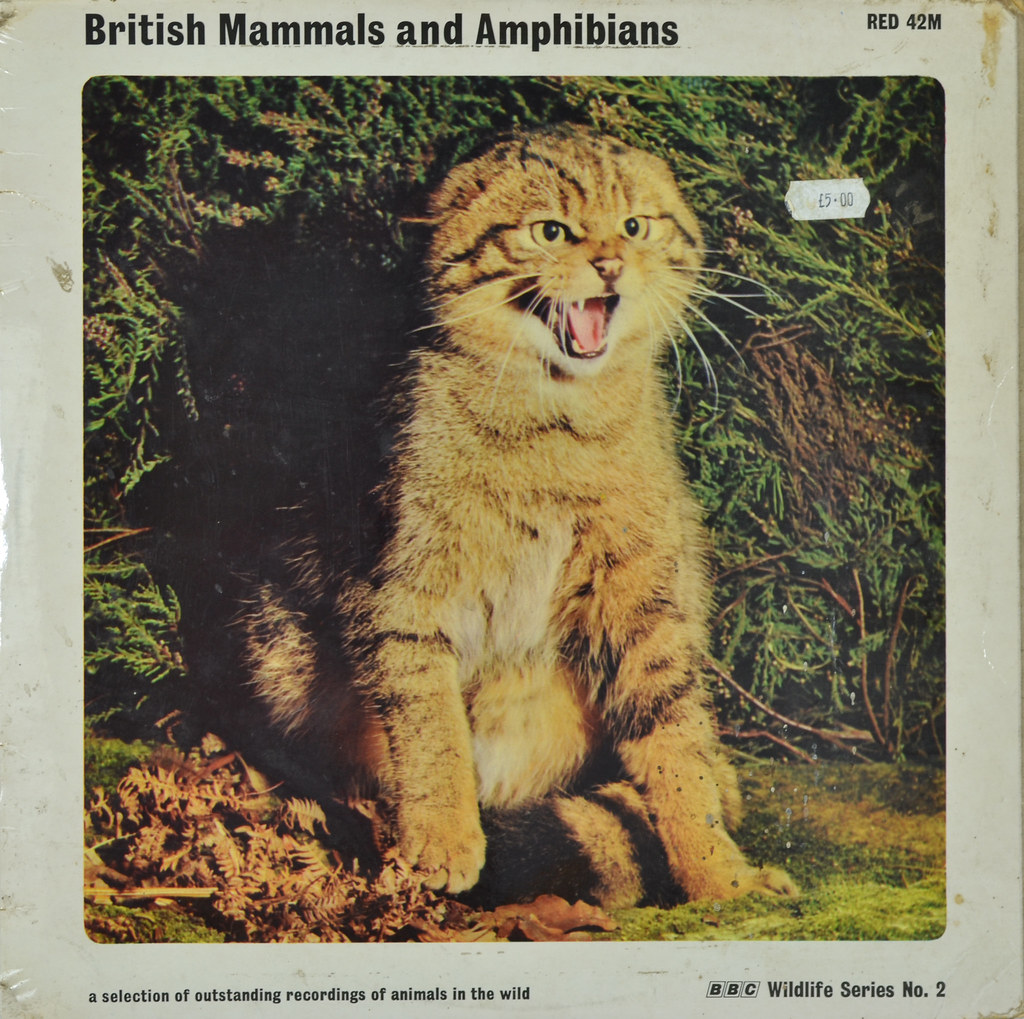
Sleeve Artwork
As he seems to have a day when he writes letters, another he sends on the 8th December is to his label colleague Andrew Prewett. He starts by saying it’s too early for a full design as he doesn’t have a running order yet. Instead he lists out again some of the grisly noises to be expected – including frogs, which didn’t make it to the final album.
He asks Andrew to think about a sleeve design concept:
“Either a montage (as in ‘Out of this World’) or one of the subjects taken individually would be good.”
R125 / 263 / 1
By this time though he has settled on a new working title: Sound Effects no.13 ……. Death and Horror. Which is strange because although this remains consistent throughout the file and is aligned with the rest of the sound effects series the actual sleeve design says not no.13, but Vol. 13. This appears to be a mistake and I have no other explanation for the anomaly.
The rest is history, as I covered in my previous post, and the montage Andrew painted elevated the album to iconic status as well as giving fair warning of the contents.
In Living Mono
At long last, on 14th December 1976, Dick Mills writes back to Mike:
“Herewith your esteemed order! The bands (all in living ‘mono’ for your delectation and subsequent transmogrification by the adept use of reverberation) are as follows:”
R125 / 263 / 1
Worth waiting for, for that rhetorical flourish alone, I think!
TARDI(S)-NESS
Before looking at what he sent over for D&H, it’s worth a cross-reference with the Radiophonic Workshop tape archive to see what Dick had been up to in the past couple of months. Luckily for Mike, Doctor Who wasn’t in production so Dick was not fully engaged. Not that he could avoid it entirely. ‘Dalek Announcements’ for Woman’s Hour, ‘Doctor Emu & The Dustbins’ for BBC1 and ‘Doctor Who Signature Tune for [schools TV] Christmas Show’ demonstrate the interest in the show at this time.
But I digress. Clearly Dick was given the time to get the tape together for Mike as his other jobs dry up in November, logging just one tape for the whole month; another Emu Broadcasting Company spoof, this time The Bionic Man (TRW 8504).
The aforementioned DW sig tune for BBC Schools (TRW 8511) is logged just ahead of “Enterprises Record (Effects – Death and Horror/Suspense)” (TRW 8512) in December. After that his work rate picks up again. I’m not sure that Dick really took a whole month to make the effects for D&H though. It might have been a case of one effect per day, but I doubt it. Dick was well used to turning out lots of effects against the clock on Doctor Who.
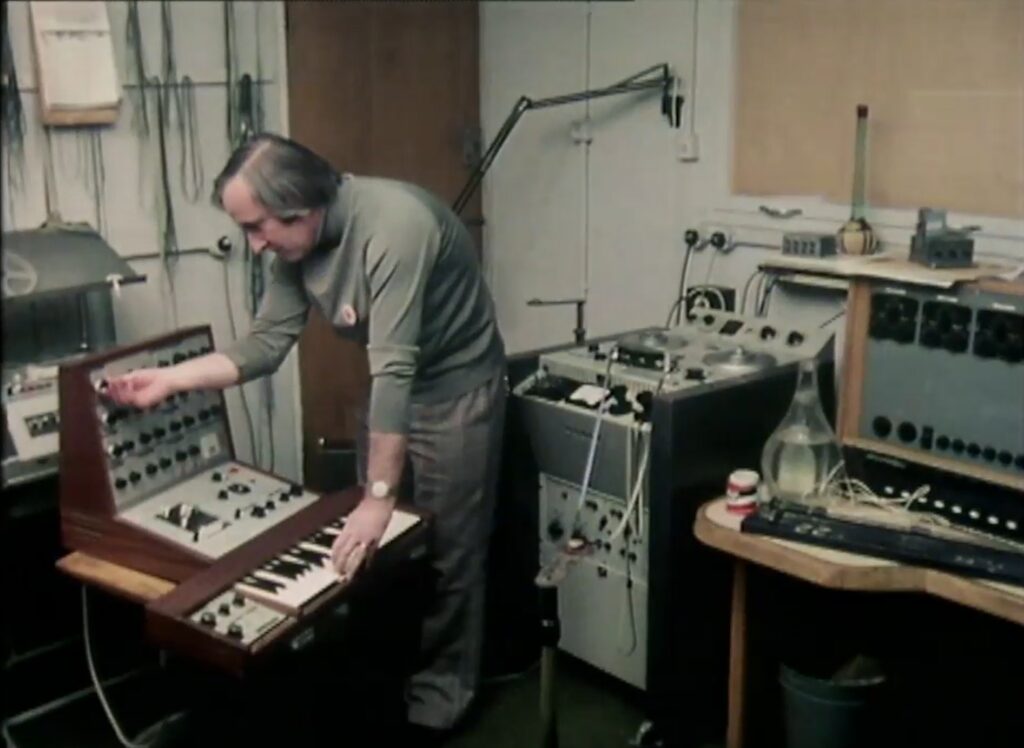
Nineteen to a dozen
Dick’s tape has a list of nineteen “bands” with some repeated examples. In full it comprised:
- Pendulum & Pit x2
- Heartbeats regular and fast
- arrow (2)
- lab backgrounds x2
- swamp
- organ
- static, short circuits etc.
- hounds “(perhaps werewolf too)”
- whizz-bangs
- explosions manifestation (2)
- feet x2.
To this list have been added Mike’s comments on timings, lengths and further details on what’s on each band. Dick signs off: “Have fun – and a Merry Christmas”.
The nineteen Radiophonic effects are then listed on another sheet, reduced to just twelve sounds. This page of notes has some technical gubbins tabulated on the left. A column of what look like frequencies where equalisation has been applied and two more columns headed A and B with plus and minus numbers. Possibly speeds of tape playback.
The ‘Radiophonics’ are listed down the page right, but not matched to the technicalities on the keft – although they are headed “now dubbed Dolby”. Mike also notes which are stereo. Dick only provided mono effects so there’s been some of that “adept use of reverberation” applied here.
The Squelching Footsteps effect which Dick supplied was used usurping an existing ‘Squelshing Footsteps’ effect which Ian had noted down from the library. A note with arrow pointing to the record EC 100Q says “check it”. 100Q is in the library catalogue as “Sound of footsteps squelching (From 78 disc) – 1964” and has one walk on each side. You can hear both here, on the BBC Rewind site and compare with Dick’s rendition on the LP. By pure fluke I also came across the original 78 RPM disc of the library effects at a record fair during the process of writing this post. This is catalogue (disc) number 6 B 42 on the Recorded Programmes Permanent Library label. I’ll write more about that another time.
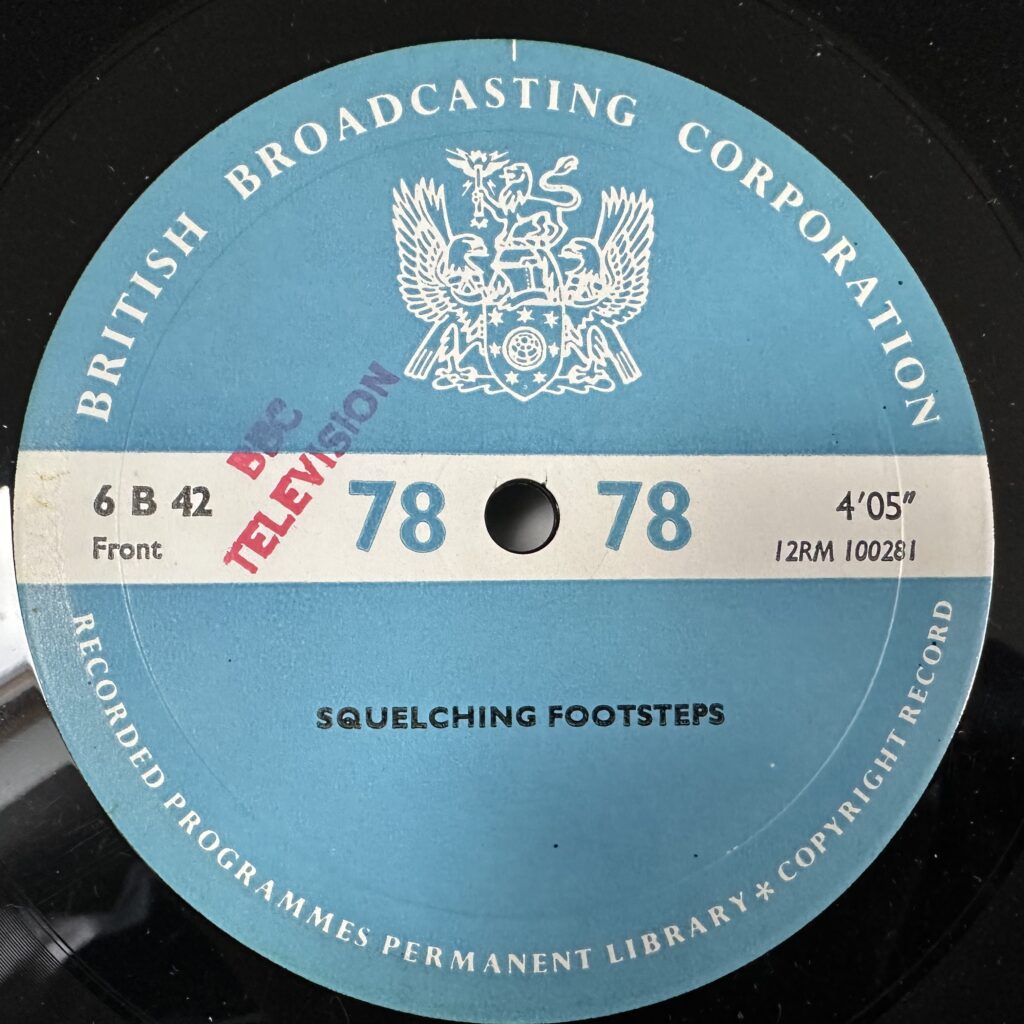
FX13
Several pages of scribbled notes follow which capture the final assembly of D&H.
Mike arranges his effects’ running order across four sheets and decides on sections A-F, with A, D, E , F on side 1 and B & C on side 2. No precise dates are on these sheets, but they must have been first worked out ahead of getting the Radiophonic tape as the notes are seemingly reworked with red pen after receiving Dick’s effects, adding an ‘R’ (often numbered) to denote each of the twelve dubbed effects. Mike also reworks some of the running order, inserting and swapping things around. There is a third and final pass in a thicker black pen too.
The sections are
- A – Execution & Torture
- B – Vocal Effects & Heartbeats
- C – Weather, Atmosphere & Bells
- D – Monsters & Animals
- E – Doors Digging & Creaking
- Originally ‘Doors & Creaks & Bangs’
- Footsteps moved to F
- later rejigged as Creaking Doors And Grave Digging for the final sleeve
- F – Musical Effects & Footsteps.
The mono effects are labelled with an asterisk, as on the final sleeve notes.
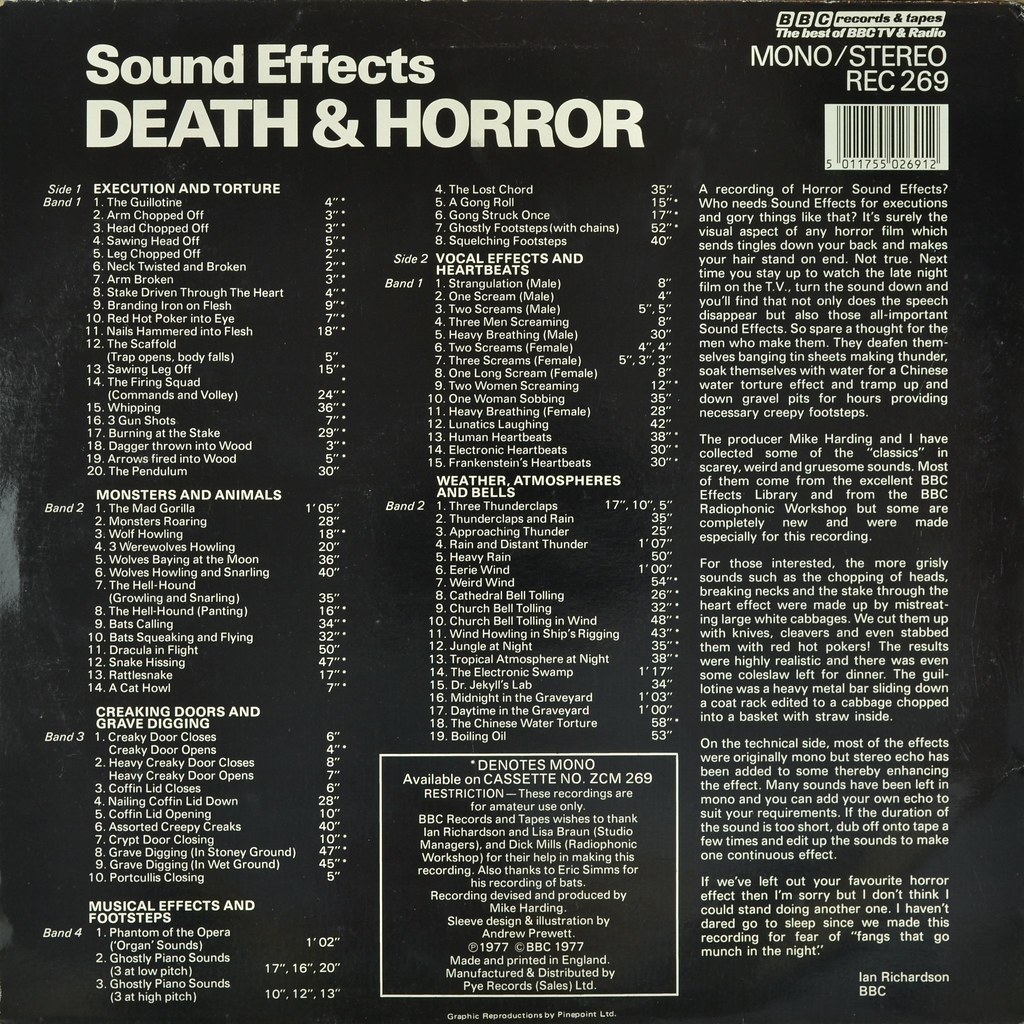
Release The Release With Hounds!
With the running order worked out and presumably a master tape created, plus the sleeve notes and other details finalised the release is ready to go. A BBC Records & Tapes Information Sheet is prepared on 7th January. This form is filled in as follows:
- Title: Sound Effects No.13 – Death and Horror
- Release Date: March 1977
- Retail Price: £1.95
The six bands are listed out but some details are missing, such as the pressing quantity. We learn something about that when Mary Whitehouse takes the BBC to task after release.
The following Monday the 10th January sees a flurry of correspondence. The cutting details are sent to Jo King (real name!) a secretary in the A&R department, and arrangements for Mike’s presence at the cutting is requested. Jo writes to Andrew Prewett with the sleeve notes, label and repertoire sheets.
The third internal communication on the 10th January is from the Copyright Department. This confirms that The Hound Of The Baskervilles is still in copyright. A note from Mike dated the 11th states that he phoned them back and told them not to proceed with clearing this as it had already been changed. Just as well! It looks like the query went unanswered for some time and Mike took the safe option of renaming it to the Hell-Hound. That must have happened quite late as it was still Hound of… on the final set of notes.
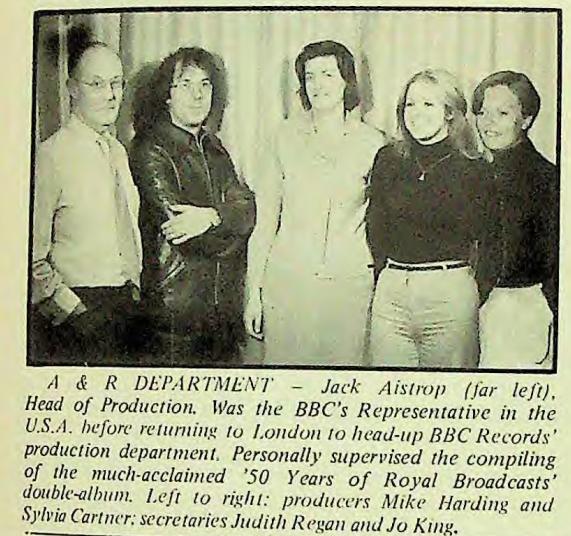
One day later the Copyright Department write to Mike to confirm that the BBC acquired the copyright for Dr Koch’s Siamese Cat recording in 1948. Phew! It would have been a bit late, after the sending of the release the day before.
Fangs Very Much
On 19th January Mike writes a brief note back to Dick with his thanks.
“I’ve used everything except the whizz-bangs, explosions and manifestation – they were too similar to Glynis’s LP”
R125 / 263 / 1
He also says that the album should be out in “March or April”. This throws a bit of doubt over the actual release date, which was supposedly March on the Information Sheet. In any case he promises to send a copy over.
Finally, another letter on the 19th January. In this case it’s a payment to Ian Richardson. This is £25 for writing the sleeve notes. It wasn’t much then either, about £140 in today’s money, but this small consideration for writing those notes was a typical fee paid at the time and does mean he got something. This may have been part of a deal struck by Roy Maynard, or just something they worked out later. It’s nice to see though and resolves the issue of payment missing from Off Beat’s production.
Conclusion
I hope you found some of that interesting! There’s plenty more to dig up about this record. The Mary Whitehouse archive at the Bodleian library in Oxford holds a wealth of correspondence about her fight against Death and Horror Sound Effects (confirmed to me by Samira Ahmed!). There are some press cuttings in the file which I’ve held back too. There’s a reference there to a BBC press release, which isn’t in the file. In the file are a couple of documents about using the sleeve design for a book cover. That doesn’t seem to have come to anything though. And, of course, there are two more editions in the Death and Horror series to come…
There is very much more to say about which library effects were used too. One day I will probably work through all the notes to trace them back the Sound Effects discs. The mad gorilla is quite intruiging as it’s called King Kong throughout the notes and doesn’t seem to come from a BBC sound effects origin at all. Also, did an angel turn into a vampire?
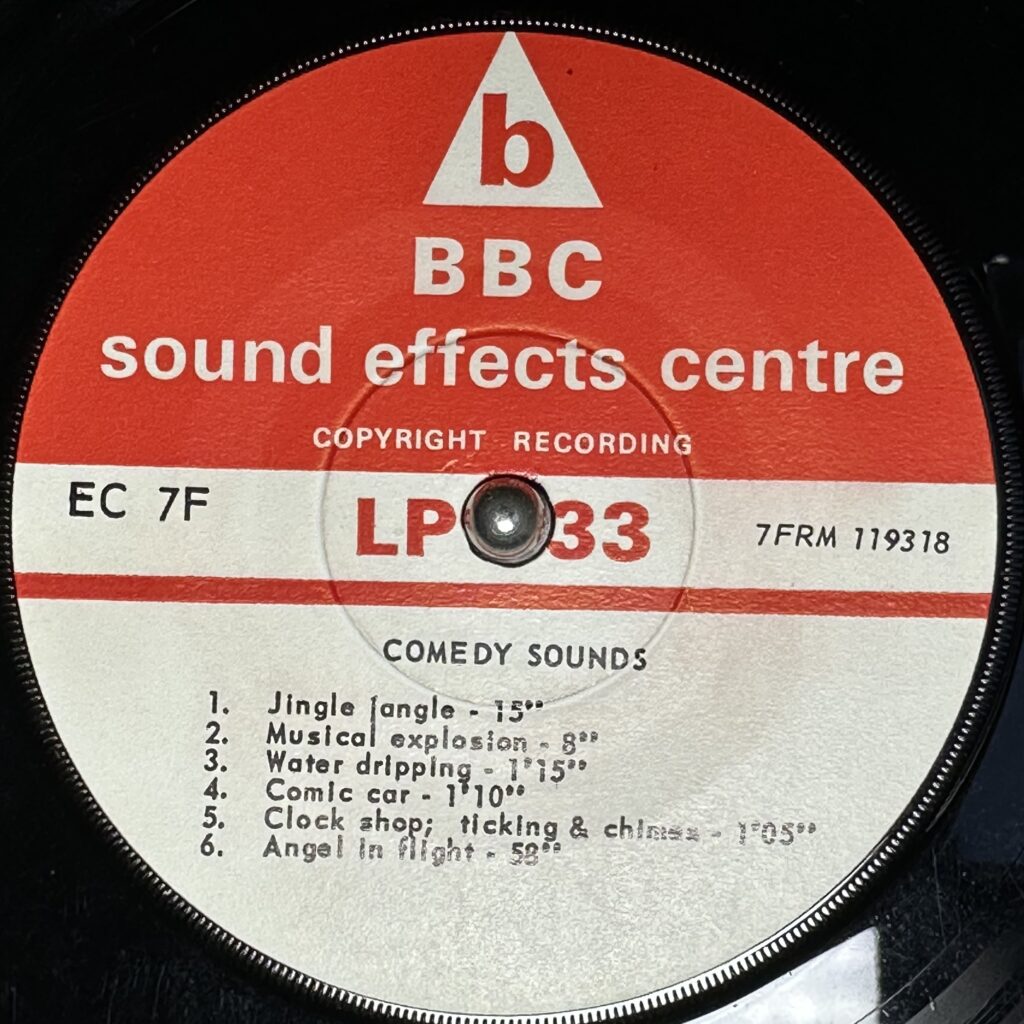
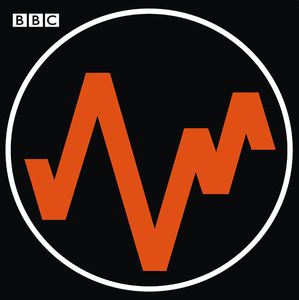

This is an amazing piece of research and thank you so much for delving into the history of this bizarre record.
For me, Death & Horror is a major part of the British “Monster Kid” movement in the 1970s… up there with James Herbert’s “The Rats”, “Fangs” corn-based snacks and Horror Top Trumps. I remember staring in disgusted awe at the cover art in the record department in my local branch of Boots sometime around 1980.
I’ve been meaning to drop some comments on this blog so now it the perfect time. Some thinking out loud… apologies for the length!
If Roy Maynard is the man responsible for “Off Beat”, does that mean he’s the voice that introduces the sounds on Side 1 of that album (“Bubbling, Musical – Sound 1”) – and why does he not appear on Side 2? Perhaps he realised he wasn’t getting paid so knocked off early.
Interesting to hear that Glynis Jones moved to BBC Records after her stint with the Radiophonic Workshop. I’d love to find out more about her, because her tracks on the 1975 self-titled Radiophonic album are incredible.
The “Man hit by a car” effect sounds like a horribly tasteless idea in this context (all the sounds that are ultimately included are fantastical or at least historical in nature). However a version of the effect would appear on “Sound Effects No 16: Disasters”, where it’s mixed into some stereo traffic noise. Maybe this one effect kick-started the “Disasters” project in the first place?
It’s funny that “Strangulation” was a stock effect and not recorded specially for the album. Perhaps this was a “most requested” effect from TV and radio producers? The mind boggles.
Astounded to find out “Red hot poker into eye” was done “for real” (minus the eye, obviously), because in my opinion it’s one of the least effective of the gore effects on side one. OK, I’m a demanding listener.
The thunder sounds are very old, but none of them appear to be the legendary “Castle Thunder” which reportedly dates back to the 1931 “Frankenstein”.
I knew that “Lunatics Laughing” pre-dated “Death & Horror” as a shorter version appears on “Sound Effects No 4” titled “Maniacal Laughter”. I wonder if Dick Mills had anything to do with it, as a snippet of the sound appears on his section of the “Radiophonic Rock” medley on the 1983 album “Roundhouse”. Would love to know who the vocal artists were.
Dick is also asked for unnatural screams “through a synthesizer” – this sounds a lot like the horrible noise that appears on “Out Of This World” called “Fiendish Shrieks”, which may be why it doesn’t make the cut here.
Nice to see that Dick Mills was asked for “lab backgrounds x2” which confirms that “Dr Jekyll’s Lab” is one of his. I’d long suspected it was as you can hear the trio of oscillators on the EMS VCS3 all working at once in the classic Mills template: oscillator 1 is emitting a low drone, the pleasing “woop! woop!” Is on oscillator 2 and the third is responsible for that lovely splashy effect that resolves itself into a two-note tone by skilful use of the VCS3’s joystick. Jean Michel-Jarre used a similar trick on “Oxygene Part 2”. Does this also mean that there’s an unused “lab background” outtake? I look forward to the 50th anniversary “Death & Horror” expanded edition.
The “Squelching footsteps” loop was a Dick Mills favourite and it wouldn’t surprise me if it’s one of his Swarfega specials (see “Whose Doctor Who” for details) – there are similar sounds in the Who story “The Sontaran Experiment” where Sarah Jane is menaced by some imaginary mud (honest!).
“The Mad Gorilla” – will we ever discover the true provenance of this bizarre effect? Was it made for a particular production, or was it brand new for Volume 13? Earlier on in the process, Mills is asked for “King Kong, swamps, squelching” but the big monkey effect isn’t mentioned in his list of 14th December 1976. There’s something about this weird sound that makes me wonder if it actually is one of Dick’s effects. I tried speeding it up once and it appears to be a melange of real animal noises, human shouting and that odd whooshing sound (Radiophonic? Is it meant to depict the gorilla swinging through the trees?).
Hopefully your further research will uncover more delicious titbits about this classic piece of grue. For example, the identity of the woman in the distorted photo on the front cover!
Also when it comes to “More Death & Horror”, is Peter Harwood still around? He was one of the key people behind that recording and doesn’t get enough credit in my opinion. His work on “The Amazing Adventures Of Morph” is outstanding and it’s weird to think he was also responsible for “Premature Burial” (shudder).
Keep up the amazing work!